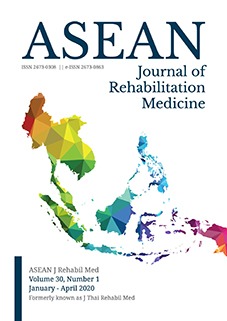Psychometric Properties of the Thai Herth Hope Index in Stroke Patients
Keywords:
psychometric properties, validity, reliability, hope, stroke, Thai Herth Hope IndexAbstract
ABSTRACT
Objectives: To investigate the psychometric properties, both validity and reliability, of the Thai version of the Herth Hope Index (Thai HHI) in stroke patients.
Study design: Descriptive study.
Setting: Department of Rehabilitation Medicine, Faculty of Medicine Siriraj Hospital, Mahidol University, Bangkok, Thailand.
Subjects: Stroke patients attending the Department of Rehabilitation Medicine during December 2017 to August 2018.
Methods: After translation to Thai language and after assessing the Thai translation for content validity, 70 stroke patients were assessed by using the Thai HHI to determine construct validity and internal consistency. Forty of those same 70 patients were then reassessed one week later to determine test-retest relia- bility. Convergent and discriminant validity were assessed by evaluating the correlation between the Thai HHI and the Rosenberg Self-Esteem Scale (RSES) and the Patient Health Questionnaire (PHQ-9), respectively, by defining the Spearman’s correlation coefficient.
Results: The Thai HHI showed good content validity (CVI = 0.98), moderate convergent validity (r = 0.563), moderate discriminant validity (r = -0.545), acceptable internal consistency (Cronbach’s alpha = 0.794), and good test-retest reliability (ICC = 0.776).
Conclusion: The Thai HHI was found to have good to moderate psychometric properties as evidenced by good content validity, moderate construct validity, acceptable internal consistency, and good test-retest reliability. These findings suggest that the Thai HHI can be used to evaluate hope among Thai stroke patients.
References
Stoner MH, Keampfer SH. Recalled life expectancy information, phase of illness and hope in cancer patients. Res Nurs Health. 1985;8:269-74.
Fitzgerald MJ. Hope: a construct central to nursing. Nurs Forum. 2007;4:9-12.
Dufault K, Martocchio BC. Symposium on compassionate care and the dying experience. Hope: its spheres and dimensions. Nurs Clin North Am. 1985;20:379-91.
Bach-y-Rita P, Bach-y-Rita E. Hope and active patient participation in the rehabilitation environment. Arch Phys Med Rehabil. 1990;71:1084-5.
Herth K. Abbreviated instrument to measure hope: development and psychometric evaluation. J Adv Nurs. 1992;17:1251-59.
Paolucci S. Epidemiology and treatment of post-stroke depression. Neuropsychiatr Dis Treat. 2008;4:145-54.
Srivastava A, Taly AB, Gupta A, Murali T. Post-stroke depression: prevalence and relationship with disability in chronic stroke survivors. Ann Indian Acad Neurol. 2010;13:123-7.
Bronstein KS. Psychosocial components in stroke. Implications for adaptation. Nurs Clin North Am. 1991;26:1007-17.
Western H. Altered living: coping, hope and quality of life after stroke. Br J Nurs. 2007;16:1266-70.
Chan KS, Li HC, Chan SW, Lopez V. Herth hope index: psychometric testing of the Chinese version. J Adv Nurs. 2011;68:2079-85.
Sartore AC, Grossi SA. Herth Hope Index-instrument adapted and validated to Portuguese. Rev Esc Enferm USP. 2008;42:227-32.
Geiser F, Zajackowski K, Conrad R, Imbierowicz K, Wegener I, Herth KA, et al. The German version of the Herth Hope index (HHI-D): development and psychometric properties. Oncol Res Treat. 2015;38:356-60.
Ripamonti CI, Buonaccorso L, Maruelli A, Bandieri E, Boldini S, Pessi MA, et al. Hope Herth index (HHI): a validation study in Italian patients with solid and hematological malignancies on active cancer treatment. Tumori. 2012;98:385-92.
Leelapattanapanit J. Hope in clients who sustained a stroke [Dissertation]. Khonkhaen: Khonkaen university; 1998.
Jørgensen HS. The Copenhagen stroke study experience. J Stroke Cerebrovasc Dis. 1996;6:5-16.
Ritchie MA. Self-esteem and hopefulness in adolescents with cancer. J Pediatr Nurs. 2001;16:35-42.
Wongpakaran T, Wongpakaran N. A comparison of reliability and construct validity between the original and revised versions of the Rosenberg Self-Esteem Scale. Psychiatry Investig. 2012;9:54-8.
Davidson PM, Dracup K, Phillips J, Daly J, Padilla G. Preparing for the worst while hoping for the best: the relevance of hope in the heart failure illness trajectory. J Cardiovasc Nurs. 2007;22:159-65.
Lotrakul M, Sumrithe S, Saipanish R. Reliability and validity of the Thai version of the PHQ-9. BMC Psychiatry. 2008;8:46.
Hinkle DE, Wiersma W, Jurs SG. Applied Statistics for the Behavioral Sciences. 5th ed. Boston: Houghton Mifflin; 2003.
Taber KS. The use of Cronbach alpha when developing and reporting research instruments in science education. Res Sci Educ. 2018;1273-96.
Koo TK, Li MY. A guideline of selecting and reporting intraclass correlation coefficients for reliability research. J Chiropr Med. 2016;15:155-63.
Suraseranivongse S, Santawat U, Kraiprasit K, Petcharatana S, Prakkamodom S, Muntraporn N. Cross-validation of a composite pain scale for preschool children within 24 hours of surgery. Br J Anaesth. 2001;87:400-5.






